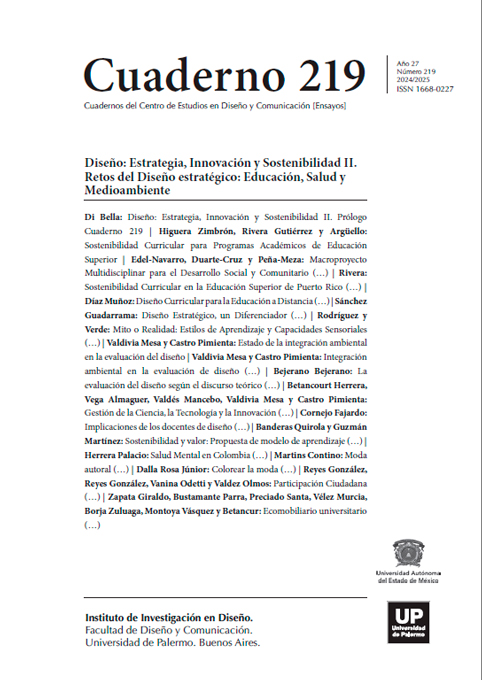Mito o Realidad: Estilos de Aprendizaje y Capacidades Sensoriales en Estudiantes Universitarios en Florida-USA
Resumen
El propósito del estudio fue determinar si las estrategias de enseñanza acorde con los estilos de aprendizaje y las capacidades sensoriales optimizan el aprendizaje en estudiantes universitarios en Florida-USA, o si es un mito.
Citas
Abella, A., Araya, M., Marco, L., & Cléries, L. (2022). Perception evaluation kit: A case study with materials and learning styles. International Journal of Technology andDesign Education, 32, 1941–1962. https://doi.org/10.1007/s10798-021-09676-4
Arbuthnott, K. & Krätzig, G. (2015). Effective teaching: Sensory learning styles versus general memory processes. Comprehensive Psychology, 4(2), 3.
DeLoach, B., Stone, W., Tolusso, D., Brown, M., Cook, E., DeLoach, G., Lambert, D., & Rueping, T. (2021). Aligning perceptual preference with instructional method in a recreational environment. Journal of Outdoor Recreation, Education, and Leadership,13(4), 46–54. https://doi.org/10.18666/JOREL-2021-V13-I4-10941
Dunn, R. & Dunn, K. (1974). Learning style as a criterion for placement in alternative programs. The Phi Delta Kappan, 56(4), 275-278.
Dunn, R., Dunn, K., & Price, G. E. (1984). Learning style inventory. Price Systems.
Hanawi, S. A., Saat, N. Z., Hanafiah, H., Taufik, M. F., Nor, A. C., Hendra, A.K., Zamzuri, N., Nek, S., Ramli, P. A., Woon, S., Basir, M. H., Sabirin, F. H., Fadzil, N. S., Azlan, T. N. (2022). Relationship between learning style and academic performance among the generation Z students in Kuala Lumpur. InternationalJournal of Pharmaceutical Research & Allied Sciences, 11(3), 40-48. https://doi.org/10.51847/bznxqWIsQL
Hatami, S. (2018). Does perceptual learning style matching affect L2 incidental vocabulary acquisition through reading? Canadian Journal of Applied Linguistics, 21(2), 102-125. https://doi.org/10.7202/1058463ar
Hernández-Sampieri, R. Fernández, C., & Baptista, P. (2017). Metodología de la investigación (6ta ed.). McGraw-Hill Interamericana Editores, S.A. de C.V.
Howard, J. P. (2014). Neuroscience and education: myths and messages. Nature Reviews Neuroscience, 15, 817–824. https://doi.org/10.1038/nrn3817
Huang, T. C. (2018). Do different learning styles make a difference when it comes to creativity? Anempirical study. Computers in Human Behavior, 100, 252–257.
Husmann, P., & O’Loughlin, V. (2018). Another nail in the coffin for learning styles? Disparities among undergraduate anatomy students’ study strategies, class performance, and reported VARK learning styles. Anatomical sciences education, 12(1). https://doi.org/10.1002/ase.1777
Kirby, J. R., Moore, P. J., & Schofield, N. J. (1988). Verbalizer-Visualizer Questionnaire–Expanded Version (VVQ) [Database record]. APA PsycTests. https://dx.doi.org/10.1037/t13456-000
Kirby, J. R., Moore, P. J., & Schofield, N. J. (1988). Verbal and visual learning styles. Contemporary Educational Psychology, 13(2), 169–184. https://doi.org/10.1016/0361-476X(88)90017-3
Knoll, A., Otani, H., Skeel, R., & Van Horn, R. (2017). Learning style, judgements of learning, and learning verbal and visual information. British Journal of Psychology, 108, 544-563. https://doi.org/10.1111/bjop.12214
Kraemer, D., Rosenberg, L., Thompson-Schill, S. (2009). The neural correlates of visual and verbal cognitive styles. Journal of Neuroscience, 29(12), 3792-3798. https://dx.doi.org/10.1523/JNEUROSCI.4635-08.2009
Kraemer, D.J., Schinazi, V.R., Cawkwell, P.B., Tekriwal, A., Epstein, R.A., & Thompson-Schill, S.L. (2017). Verbalizing, visualizing, and navigating: The effect of strategies on encoding a large-scale virtual environment. Journal of Experimental Psychology: Learning, Memory, and Cognition, 43(4), 611-621. https://doi.org/10.1037/xlm0000314
Lethaby, C., & Mayne, R. (2018). The problem with learning styles: debunking the meshing hypothesis in English language teaching. Impact: Journal of the Chartered College of Teaching. https://my.chartered.college/impact_article/the-problem-with-learning-stylesdebunking-the-meshing-hypothesis-in-english-language-teaching/
Manes, F., & Niro, M. (2014). Usar el Cerebro. Conocer nuestra mente para vivir mejor (9na. ed., p. 76). Paidós.
Papadatou, P. M., Touloumakos, A., Koutouveli, C., & Barrable, A. (2021). The learning styles neuromyth: when the same term means different things to different teachers. European Journal of Psychology of Education, 36, 511–531. https://doi.org/10.1007/s10212-020-00485-2
Pashler, H., McDaniel, M., Rohrer, D., & Bjork, R. (2009). Learning styles: Concepts and evidence. Psychological Science in the Public Interest, 9(3), 105–119. https://doi.org/10.1111/j.1539-6053.2009.01038.x
Rogowsky, B. A., Calhoun, B. M., & Tallal, P. (2015). Matching learning style to instructional method: Effects on comprehension. Journal of Educational Psychology, 107(1), 64–78. https://doi.org/10.1037/a0037478
Wang, S. H., & Willard, E. (2022). The Relationship between learning styles, study effort and English language proficiency in Chinese middle schools. Asian Journal of Research in Education and Social Sciences, 4(2), 209-219. https://doi.org/10.55057/ajress.2022.4.2.18
Willingham, D., Hughes, E., & Dobolyi, D. (2015). The scientific status of learning styles theories. Teaching of Psychology, 42(3), 266-271. https://doi.org/10.1177/0098628315589505
Los autores/as que publiquen en esta revista ceden los derechos de autor y de publicación a "Cuadernos del Centro de Estudios de Diseño y Comunicación", Aceptando el registro de su trabajo bajo una licencia de atribución de Creative Commons, que permite a terceros utilizar lo publicado siempre que de el crédito pertinente a los autores y a esta revista.


